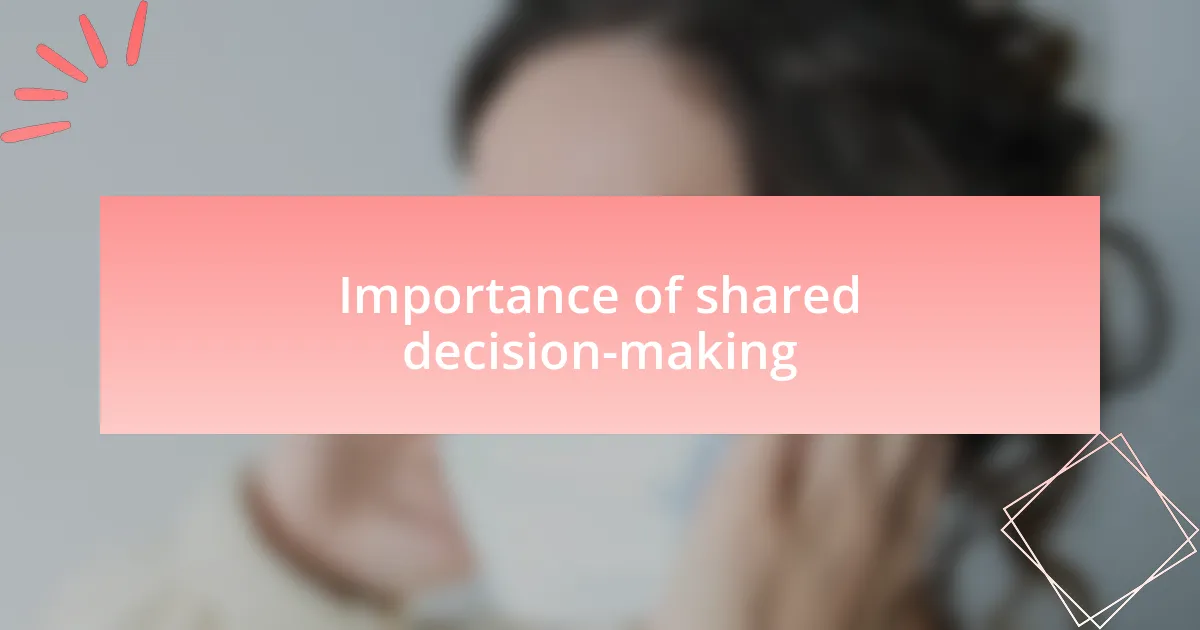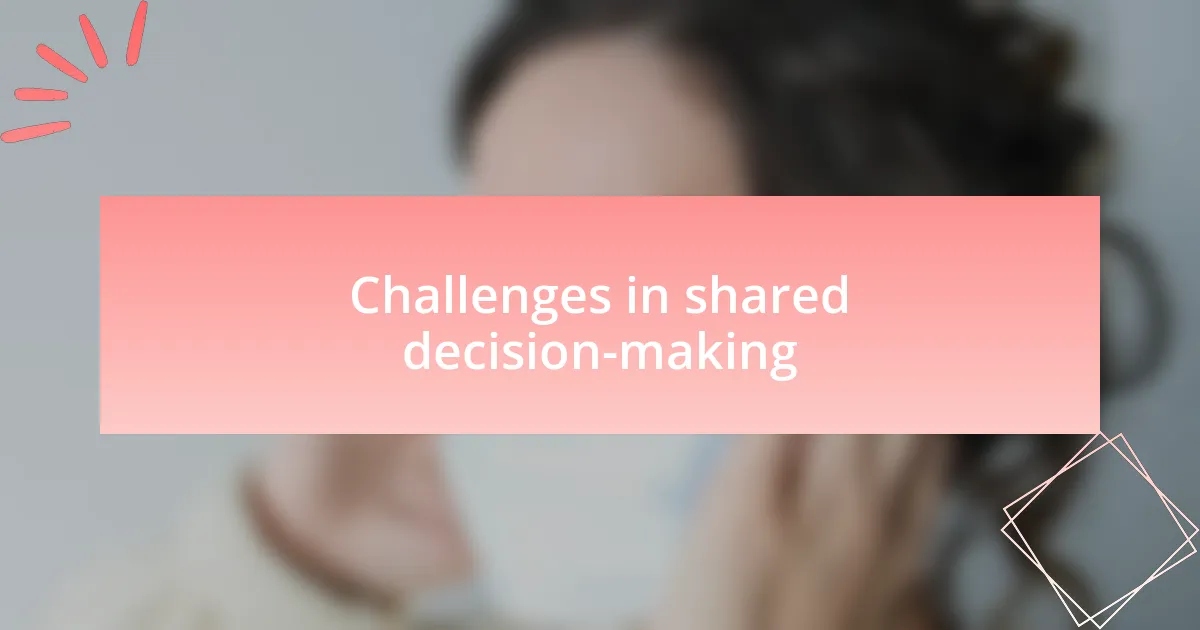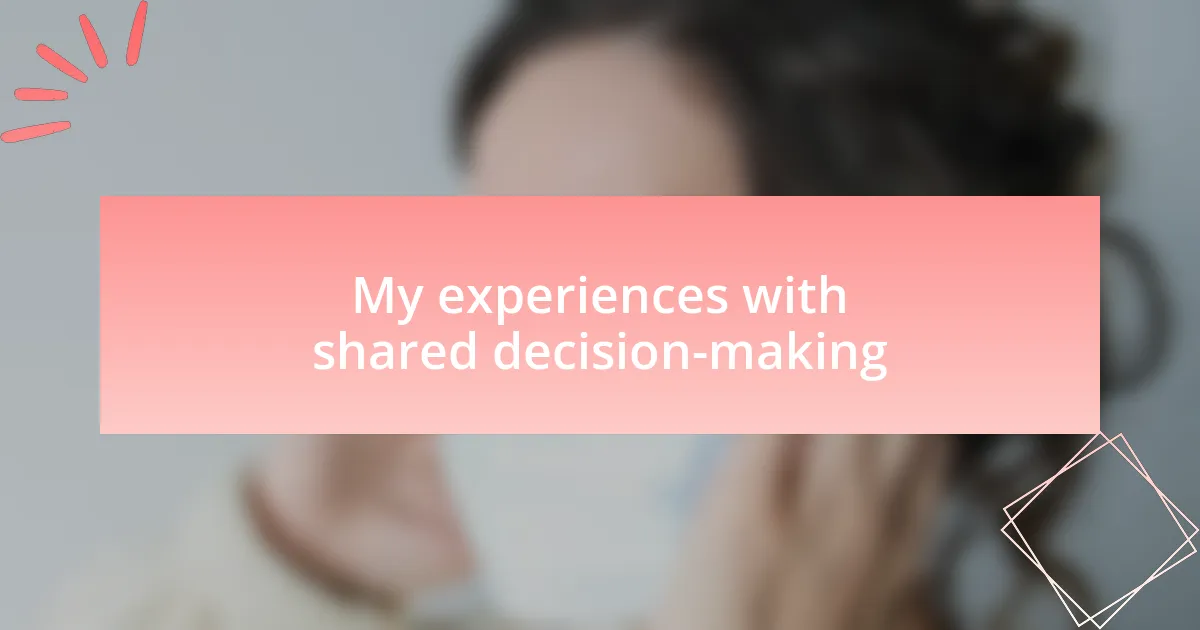Key takeaways:
- Shared decision-making enhances patient engagement and satisfaction, leading to better adherence to treatment plans.
- Effective communication is crucial; barriers such as medical jargon and time constraints can hinder the decision-making process.
- Building trust and rapport between patients and providers fosters an environment conducive to open discussions about health preferences.
- Utilizing visual aids and encouraging questions can facilitate deeper conversations and empower patients in their healthcare journeys.

What is shared decision-making
Shared decision-making is a collaborative process that involves patients and healthcare providers working together to make informed decisions about treatment options. I’ve often found that when patients are active participants in these discussions, it leads to a deeper understanding of their health issues and a more personalized care experience. Isn’t it empowering to have a say in what happens to your health?
This approach emphasizes open communication, where providers share their expertise and patients share their preferences or concerns. I remember a time when a doctor sat down with me to discuss my treatment choices. It wasn’t just about what was medically necessary; it was about what I felt comfortable with. This experience reinforced for me how vital it is to have these conversations—how can we expect to make the best decisions without discussing our values and fears?
Shared decision-making also fosters a sense of ownership over one’s health journey. When patients feel heard, they’re more likely to adhere to treatment plans and take proactive steps towards their wellness. It raises the question: What benefits might we all see if engaging in meaningful dialogue became the norm in healthcare? From my perspective, the potential for improved outcomes and satisfaction is profound.

Importance of shared decision-making
The importance of shared decision-making can’t be overstated. When patients feel involved in their care, it can dramatically alter their experience. I recall one instance where I voiced my concerns about a medication. The discussion that followed not only addressed my worries but also led to an alternative that better suited my lifestyle and preferences. Isn’t it interesting how a simple conversation can lead to such positive changes?
Moreover, shared decision-making is vital for building trust between healthcare providers and patients. I’ve noticed that when my doctor takes the time to explain options and truly listens to my input, it creates an environment where I feel valued. This trust encourages me to be more open about my health, leading to better outcomes. Trust, after all, is the foundation of effective healthcare—how can we hope to achieve great results if we don’t share our fears and aspirations?
Ultimately, embracing shared decision-making can enhance patient satisfaction and improve adherence to treatment plans. I think back to the times when I felt sidelined in a decision; I often struggled to follow through on suggested treatments because they didn’t feel right for me. Engaging in meaningful discussions transforms the process, making it not just about compliance but about partnership. Isn’t that the goal of healthcare—to work together towards a healthier future?

Challenges in shared decision-making
Navigating the path to effective shared decision-making comes with its hurdles, one of the most pressing being communication barriers. I remember a time when I met with a specialist who used complex medical jargon that was hard for me to follow. It left me feeling a bit lost, questioning whether I truly understood my options. How can we make informed choices if we can’t grasp what’s being discussed?
Another challenge is the difference in priorities between patients and practitioners. I’ve often felt that while my doctor focused on clinical outcomes, I was more concerned about how a treatment fit into my daily life. It dawned on me how crucial it is for both parties to align their goals. If we don’t, won’t that lead to frustration on both sides, ultimately hindering the decision-making process?
Time constraints in busy healthcare settings often prevent thorough discussions. There was a consultation I had where I felt rushed, leading me to quickly consent to a treatment plan I hadn’t fully considered. This experience made me realize how essential it is to advocate for enough time during appointments. If patients don’t have the opportunity to reflect and ask questions, are we really engaging in shared decision-making, or just ticking boxes?

My experiences with shared decision-making
My experiences with shared decision-making have often left me reflecting on the dynamics at play between patient and provider. I recall a moment during a consultation when my doctor presented a few treatment options. As she explained the pros and cons, I felt a surge of empowerment; it was refreshing to be part of the conversation rather than a passive recipient of information. But then I wondered, how often do we truly get to voice our preferences, or are we just following the prescribed road?
In another instance, I had an encounter that starkly highlighted the importance of shared decision-making. I was given a choice between two medications, each with different side effects. When I expressed my concerns about the potential impacts on my daily routine, the doctor acknowledged my worries and we explored alternatives together. It was a pivotal moment; it felt less like an imposition and more like a partnership. Doesn’t engaging in this way transform our healthcare experiences into something more meaningful?
Yet, I’ve also faced situations where I felt my input was disregarded. During a follow-up appointment, I voiced concerns about a treatment’s side effects, only to be met with a somewhat dismissive response. In that moment, I felt undervalued, leading me to question the effectiveness of shared decision-making in that context. After all, if my concerns aren’t taken seriously, can we really call it collaboration? Those experiences have only strengthened my belief in the need for a more inclusive dialogue in healthcare settings.

Strategies for effective shared decision-making
Effective shared decision-making begins with building a strong rapport between patients and providers. In my experience, when doctors take the time to create a welcoming atmosphere, it encourages patients to speak openly. I remember a visit where my physician began the conversation by asking about my lifestyle and values, setting the stage for a more collaborative discussion about my health. How can one truly decide without knowing the person behind the medical history?
Another strategy that I’ve found impactful is the use of visual aids or decision aids during consultations. I’ve seen diagrams and charts transform complex medical information into something digestible and engaging. During one appointment, a visual aid helped clarify the risks and benefits of a surgical procedure; it not only facilitated understanding but also sparked a deeper conversation about my preferences. Isn’t it fascinating how a simple tool can be the key to unlocking meaningful dialogue?
Lastly, fostering an environment that encourages questions is vital. I often sense hesitation in patients, including myself, when it comes to asking about our care. One time, I mustered the courage to ask a seemingly basic question about my treatment plan, and the doctor responded with patience and detail, which built my confidence. It made me realize: if we’re not being curious, are we fully participating in our healthcare journey? Encouraging curiosity can turn a standard appointment into an empowering partnership.